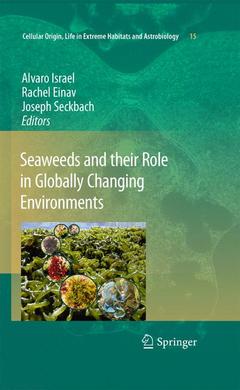Description
Seaweeds and their Role in Globally Changing Environments, 2010
Cellular Origin, Life in Extreme Habitats and Astrobiology Series, Vol. 15
Coordinators: Israel Alvaro, Einav Rachel, Seckbach Joseph
Language: English
Subjects for Seaweeds and their Role in Globally Changing Environments:
Keywords
Biodiversity; Flora; Global warming; Permafrost; algae; aquaculture; bacteria; climate change; ecology; ecosystem; ecosystems; emissions; environment; physiology
Publication date: 09-2012
480 p. · 15.5x23.5 cm · Paperback
Publication date: 07-2010
480 p. · 15.5x23.5 cm · Hardback
Description
/li>Contents
/li>Comment
/li>
Global warming is accelerating faster than the ability for natural repair, and environmental stresses are damaging ecosystems, all affecting physical and biological systems on Earth. A new Nasa-led study shows that human activity has caused climate changes resulting in permafrost thawing, acid rain, and lower productivity in lakes as well as increased emissions of greenhouse gases, including CO2, N20, CH4, CF3, and CFC. Marine plants play a vital role in maintaining the balance of marine environments, while serving as a source of food for humankind and important chemical compounds. Microalgae and seaweed have enormous potential for reducing global warming and climate change. During photosynthesis algae grow, draw CO2 from the atmosphere, release oxygen, and produce solar biofuel. Experts in the life of marine plant ecosystems in globally changing environments contributed chapters to this book. The target readers are phycologists, ecologists, atmospheric scholars, conservationists, environmentalists, and ecologically aware laymen.
First book addressing global change and seaweeds
Interdisciplinary approaches of seaweeds and global change
In spite of the complexity of the topic, it can easily be read by everyone
An updated information of current and future global changes in the marine environment
Integration of decades of research and experience of top scientists in the field of marine biology
Includes supplementary material: sn.pub/extras




